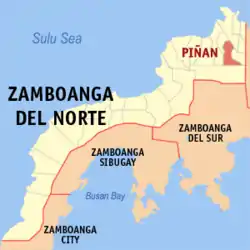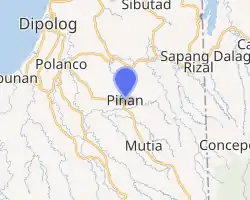Piñan
Piñan, officially the Municipality of Piñan (Cebuano: Lungsod sa Piñan; Subanen: Benwa Piñan; Chavacano: Municipalidad de Piñan; Tagalog: Bayan ng Piñan), is a 4th class municipality in the province of Zamboanga del Norte, Philippines. According to the 2020 census, it has a population of 20,221 people. [3]
Piñan | |
|---|---|
| Municipality of Piñan | |
 Seal | |
Nickname(s):
| |
 Map of Zamboanga del Norte with Piñan highlighted | |
OpenStreetMap  | |
.svg.png.webp) Piñan Location within the Philippines | |
| Coordinates: 8°28′56″N 123°27′00″E | |
| Country | Philippines |
| Region | Zamboanga Peninsula |
| Province | Zamboanga del Norte |
| District | 1st district |
| Founded | August 22, 1951 |
| Barangays | 22 (see Barangays) |
| Government | |
| • Type | Sangguniang Bayan |
| • Mayor | Cecilia J. Carreon |
| • Vice Mayor | Deogracias T. Cimafranca |
| • Representative | Romeo M. Jalosjos Jr. |
| • Municipal Council | Members |
| • Electorate | 14,309 voters (2019) |
| Area | |
| • Total | 93.75 km2 (36.20 sq mi) |
| Elevation | 68 m (223 ft) |
| Highest elevation | 274 m (899 ft) |
| Lowest elevation | 12 m (39 ft) |
| Population | |
| • Total | 20,221 |
| • Density | 220/km2 (560/sq mi) |
| • Households | 4,609 |
| Economy | |
| • Income class | 4th municipal income class |
| • Poverty incidence | 46.49% (2018)[4] |
| • Revenue | ₱112,538,000.00 (2020) |
| • Assets | ₱321,768,000.00 (2020) |
| • Expenditure | ₱124,384,000.00 (2020) |
| • Liabilities | ₱45,224,000.00 (2020) |
| Service provider | |
| • Electricity | Zamboanga del Norte Electric Cooperative (ZANECO) |
| Time zone | UTC+8 (PST) |
| ZIP code | 7105 |
| PSGC | |
| IDD : area code | +63 (0)65 |
| Native languages | Subanon Cebuano Chavacano Tagalog |
| Website | www |
It is also known as New Piñan.[5]
Etymology
Piñan came from a Subano term “pinyayan” which means “tabuan” or a trading place. Before it was established as a formal settlement, this place has been a trading point between natives area and ambulant peddlers. Hence, sometime in 1903, Captain Finley, a military governor in Zamboanga established a “tabuan” in what is now known as Barangay Del Pilar. The “tabuan” became what is known to be Piñan and when the municipality was created, it was called New Piñan to vary it from Piñan.
History
From the time of its foundation, The name of the municipality of New Piñan was later changed to Piñan under Republic Act No. 2846 on June 19, 1960.
The inhabitants of Piñan were engaged in farming, they cultivated their field by using “kaingin” system in which the land was cleared by setting fire to the woody plant and bushes, after which, holes were bored in the ground with a pointed sticks and the seeds were then planted there. They also used wooded plows and harrows drawn by Carabao's . Then, finally, Piñan became the source of farm production using their famous horses or cattle driven caretela, until most of the time, people from neighboring municipalities go to Piñan to purchase agricultural products, in which then, they established a so-called “tabuan”.
Other version states that Piñan got its name from the native word “piña”, a pineapple fruit that grows abundantly in this locality before its creation. Vast tracts of pineapple plantations can be seen all over the area. Because of abundance of Piña fruits, natives called the place Piñan.
Piñan acquired its juridical personality on August 22, 1951, by virtue of Executive Order No. 457 by his Excellency, President of the Philippines, Elpedio Quirino, and an act creating the municipality of Piñan, from the municipality of Dipolog.
Piñan became a municipality on December 8, 1951, at 2:35 p.m. and was inaugurated through the painstaking effort of Serapio J. Datoc, who was at the time, the Governor of the province of Zamboanga (with the north portion now the province of Zamboanga del Norte), and declared as an independent municipality separate from its mother municipality of Dipolog (now city of Dipolog.)[6]
Geography
Barangays
Piñan is politically subdivided into 22 barangays.
- Bacuyong
- Bagong Silang
- Calican
- Del Pilar
- Desin
- Dilawa
- Dionum
- Lapu-lapu
- Lower Gumay
- Luzvilla
- Poblacion North
- Poblacion South
- Santa Fe
- Segabe
- Sikitan
- Silano
- Teresita
- Tinaytayan
- Ubay (Daan Tipan)
- Upper Gumay
- Villarico
Climate
| Climate data for Piñan, Zamboanga del Norte | |||||||||||||
|---|---|---|---|---|---|---|---|---|---|---|---|---|---|
| Month | Jan | Feb | Mar | Apr | May | Jun | Jul | Aug | Sep | Oct | Nov | Dec | Year |
| Average high °C (°F) | 28 (82) |
29 (84) |
30 (86) |
31 (88) |
30 (86) |
29 (84) |
29 (84) |
29 (84) |
30 (86) |
29 (84) |
29 (84) |
29 (84) |
29 (85) |
| Average low °C (°F) | 23 (73) |
23 (73) |
23 (73) |
23 (73) |
24 (75) |
24 (75) |
24 (75) |
24 (75) |
24 (75) |
24 (75) |
24 (75) |
23 (73) |
24 (74) |
| Average precipitation mm (inches) | 104 (4.1) |
76 (3.0) |
92 (3.6) |
97 (3.8) |
199 (7.8) |
238 (9.4) |
195 (7.7) |
193 (7.6) |
178 (7.0) |
212 (8.3) |
171 (6.7) |
110 (4.3) |
1,865 (73.3) |
| Average rainy days | 14.7 | 12.5 | 15.8 | 17.5 | 27.6 | 28.5 | 29.0 | 27.5 | 26.9 | 27.9 | 23.5 | 18.2 | 269.6 |
| Source: Meteoblue [7] | |||||||||||||
Demographics
| Year | Pop. | ±% p.a. |
|---|---|---|
| 1960 | 24,699 | — |
| 1970 | 12,335 | −6.70% |
| 1975 | 13,121 | +1.25% |
| 1980 | 14,373 | +1.84% |
| 1990 | 15,419 | +0.71% |
| 1995 | 19,447 | +4.44% |
| 2000 | 17,950 | −1.70% |
| 2007 | 18,669 | +0.54% |
| 2010 | 20,088 | +2.70% |
| 2015 | 20,161 | +0.07% |
| 2020 | 20,221 | +0.06% |
| Source: Philippine Statistics Authority [8] [9] [10][11] | ||
Economy
| Poverty Incidence of Piñan | |
| Source: Philippine Statistics Authority[12][13][14][15][16][17][18] | |
References
- Municipality of Piñan | (DILG)
- "2015 Census of Population, Report No. 3 – Population, Land Area, and Population Density" (PDF). Philippine Statistics Authority. Quezon City, Philippines. August 2016. ISSN 0117-1453. Archived (PDF) from the original on May 25, 2021. Retrieved July 16, 2021.
- Census of Population (2020). "Region IX (Zamboanga Peninsula)". Total Population by Province, City, Municipality and Barangay. PSA. Retrieved 8 July 2021.
- "PSA Releases the 2018 Municipal and City Level Poverty Estimates". Philippine Statistics Authority. 15 December 2021. Retrieved 22 January 2022.
- "Zamboanga del Norte : Municipality of Pinan". Old website of Zamboanga del Norte. Archived from the original on 17 November 2002. Retrieved 15 October 2020.
- "About Piñan". 2012.
{{cite web}}: CS1 maint: url-status (link) - "Piñan: Average Temperatures and Rainfall". Meteoblue. Retrieved 30 April 2020.
- Census of Population (2015). "Region IX (Zamboanga Peninsula)". Total Population by Province, City, Municipality and Barangay. PSA. Retrieved 20 June 2016.
- Census of Population and Housing (2010). "Region IX (Zamboanga Peninsula)". Total Population by Province, City, Municipality and Barangay. NSO. Retrieved 29 June 2016.
- Censuses of Population (1903–2007). "Region IX (Zamboanga Peninsula)". Table 1. Population Enumerated in Various Censuses by Province/Highly Urbanized City: 1903 to 2007. NSO.
- "Province of Zamboanga del Norte". Municipality Population Data. Local Water Utilities Administration Research Division. Retrieved 17 December 2016.
- "Poverty incidence (PI):". Philippine Statistics Authority. Retrieved 28 December 2020.
- https://psa.gov.ph/sites/default/files/NSCB_LocalPovertyPhilippines_0.pdf; publication date: 29 November 2005; publisher: Philippine Statistics Authority.
- https://psa.gov.ph/sites/default/files/2003%20SAE%20of%20poverty%20%28Full%20Report%29_1.pdf; publication date: 23 March 2009; publisher: Philippine Statistics Authority.
- https://psa.gov.ph/sites/default/files/2006%20and%202009%20City%20and%20Municipal%20Level%20Poverty%20Estimates_0_1.pdf; publication date: 3 August 2012; publisher: Philippine Statistics Authority.
- https://psa.gov.ph/sites/default/files/2012%20Municipal%20and%20City%20Level%20Poverty%20Estima7tes%20Publication%20%281%29.pdf; publication date: 31 May 2016; publisher: Philippine Statistics Authority.
- https://psa.gov.ph/sites/default/files/City%20and%20Municipal-level%20Small%20Area%20Poverty%20Estimates_%202009%2C%202012%20and%202015_0.xlsx; publication date: 10 July 2019; publisher: Philippine Statistics Authority.
- "PSA Releases the 2018 Municipal and City Level Poverty Estimates". Philippine Statistics Authority. 15 December 2021. Retrieved 22 January 2022.
External links